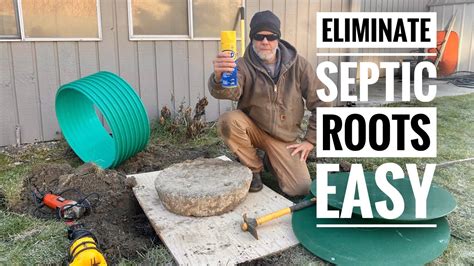The Best Way to Kill Roots in Your Septic System: Prevention and Solutions
Dealing with tree roots invading your septic system is a homeowner's nightmare. These intrusive root systems can cause serious damage, leading to costly repairs and potential environmental hazards. This comprehensive guide explores the best methods for killing roots already in your septic system, and more importantly, how to prevent future invasions.
Why Do Roots Invade Septic Systems?
Septic systems, especially older ones, often offer an attractive environment for tree roots. The pipes contain wastewater rich in nutrients, providing a feast for hungry roots seeking water and sustenance. The relatively shallow depth of septic lines makes them particularly vulnerable.
What are the Signs of Root Intrusion in Your Septic System?
Identifying the problem early is crucial. Keep an eye out for these telltale signs:
- Slow draining drains: This is often the first indicator. If your sinks, showers, or toilets drain slowly, root intrusion could be the culprit.
- Gurgling sounds from drains: These noises often signal a blockage or partial blockage caused by roots.
- Recurring sewage backups: This is a serious problem indicating significant root blockage.
- Unusual lush growth above the septic system: If you notice unusually vibrant vegetation directly above your septic tank or drain field, it could be drawing nutrients from the wastewater.
- Unexpectedly high water levels in your septic tank: Roots can obstruct the effluent filter or pipes, causing the tank to fill up too quickly.
How to Kill Roots in Your Septic System: Chemical Methods
While many methods exist, chemical approaches should be used cautiously and only as a last resort. Always follow product instructions carefully and consider the potential impact on the environment.
Copper Sulfate: A Common, but Controversial Choice
Copper sulfate is a root killer often used in septic systems. It's relatively inexpensive and readily available. However, its effectiveness varies, and excessive use can harm beneficial bacteria in the septic system, hindering its proper function. It's crucial to use this only as directed and in accordance with local regulations.
Root Killers Specifically Designed for Septic Systems
Some commercially available root killers are formulated for septic systems, claiming to be gentler on the beneficial bacteria. Always read the labels carefully and ensure the product is specifically designed for this application. Even these products should be used sparingly.
How to Kill Roots in Your Septic System: Non-Chemical Methods
These methods offer a more environmentally friendly approach to root control:
Root Cutting with a High-Pressure Water Jet
Professional plumbers often use high-pressure water jets to physically remove roots from pipes. This is a more effective method than chemicals and avoids harming the septic system's bacterial ecosystem.
Root Removal Through Excavation (In Extreme Cases)
If root intrusion is extensive and other methods fail, excavation may be necessary. This involves digging up the affected pipes and physically removing the roots. This is an expensive and disruptive solution but sometimes unavoidable.
Preventing Root Intrusion: The Best Long-Term Solution
Preventing root invasion is far more effective and cost-efficient than dealing with the problem once it arises. Here are some preventative measures:
Maintain Proper Landscaping:
- Plant trees and shrubs a significant distance from your septic system. Consult local codes and guidelines; a common recommendation is at least 10 feet.
- Regularly trim roots growing near your septic system. Early intervention prevents major problems.
- Avoid planting aggressive, fast-growing root systems near your septic system.
Regular Septic Tank Inspection and Maintenance:
- Schedule regular inspections by a qualified septic professional. Early detection of root intrusion enables prompt action.
- Pump your septic tank as recommended. A well-maintained system is less attractive to roots.
Using Root Barriers:
- Install root barriers before any significant planting. These barriers can significantly reduce the risk of root penetration.
Addressing Specific Concerns
How can I prevent roots from entering my septic tank in the future? The most effective prevention involves proper landscaping, maintaining a sufficient distance between trees and the septic system, and regular inspections.
What is the best way to treat roots in my drain field? For the drain field, the least destructive approach usually involves using a root-killing chemical specifically designed for septic systems, carefully following the instructions. However, professional cleaning using a high-pressure water jet may be a better and less environmentally damaging option.
Are there any natural ways to kill roots in a septic system? While some natural methods exist, they are generally less effective than chemical or professional solutions. Maintaining a healthy distance from trees and regular maintenance are your best natural defenses.
This guide provides a comprehensive overview of dealing with roots in your septic system. Remember, prevention is always the best approach. Consulting with a qualified plumber or septic system professional is recommended for any significant problem or before undertaking any major repair or treatment. They can offer tailored advice and solutions specific to your situation.

